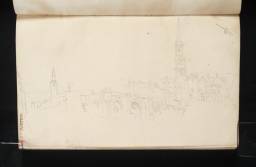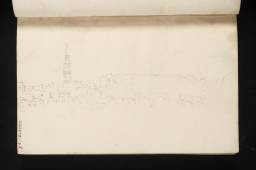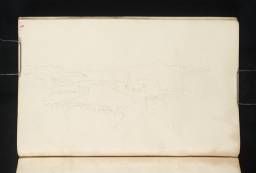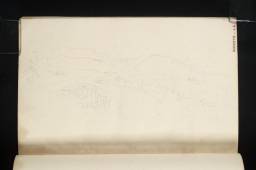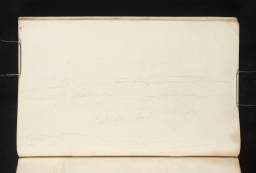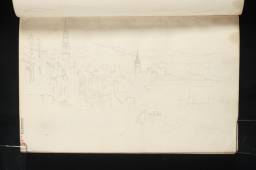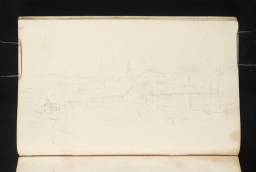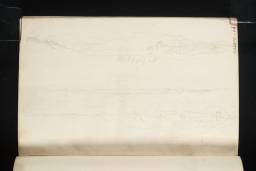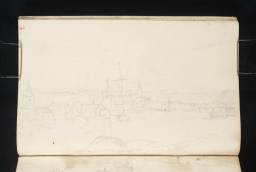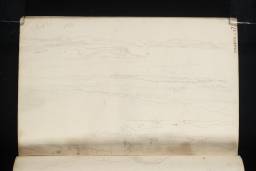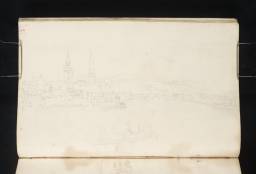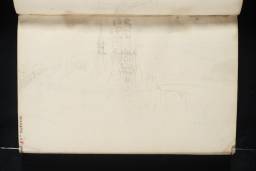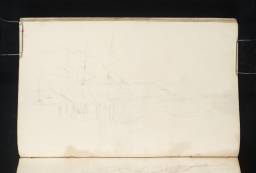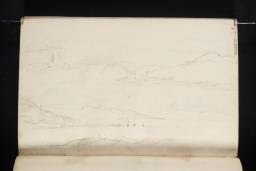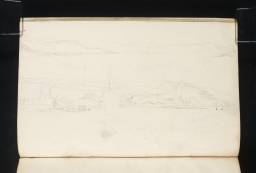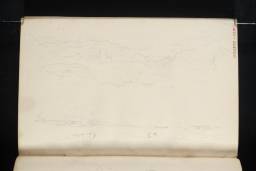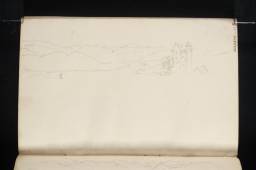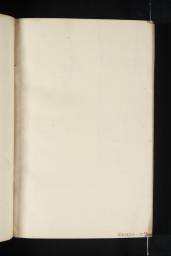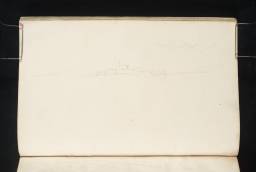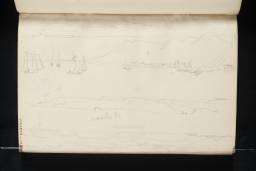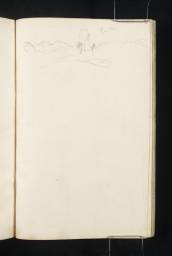Turner Bequest CCLXXVII
Sketchbook bound with marbled paper-covered cardboard covers and a red leather spine.
146 pages of off-white wove paper with no watermark by an unknown maker. Peter Bower has pointed out that the paper was probably made on a cylinder mould machine, and that the only maker with such machines in Britain in this period was John Dickinson of Apsley and Nash Mills, Hertfordshire. The sketchbook, however, was purchased in Scotland at D. Morrison & Co. Booksellers, Stationers and bookbinders in Inverness.
Approximate page size 104 x 163 mm
Numbered ‘283’ as part of the Turner Schedule in 1854 and endorsed by the executors of the Turner Bequest on the inside front cover.
146 pages of off-white wove paper with no watermark by an unknown maker. Peter Bower has pointed out that the paper was probably made on a cylinder mould machine, and that the only maker with such machines in Britain in this period was John Dickinson of Apsley and Nash Mills, Hertfordshire. The sketchbook, however, was purchased in Scotland at D. Morrison & Co. Booksellers, Stationers and bookbinders in Inverness.
Approximate page size 104 x 163 mm
Numbered ‘283’ as part of the Turner Schedule in 1854 and endorsed by the executors of the Turner Bequest on the inside front cover.
Stamped in black on the front cover ‘CCLXXVII’ top right, and blindstamped on the red leather at the upper left with the Turner Bequest stamp. There is no label on the spine or any inscriptions on the back cover. The inside front cover is inscribed by Turner and with the endorsements of his executors:
Inscribed in pencil by ?Turner ‘Inverness’ centre
Inscribed in pencil ‘580’ top centre
Inscribed in brown ink by Henry Scott Trimmer ‘No 283 Contains 48 leaves ? Pencil Sketches on both ? sides – [signed] H.S. Trimmer’ top
Signed in pencil by John Prescott Knight ‘JPK’ beneath Charles Turner’s signature
Signed in pencil by Charles Lock Eastlake ‘C.L.E’ to the right of Knight’s signature
Inscribed in pencil by A.J. Finberg ‘CCLXXVII’ top right
Stamped in black ‘CCLXXVII’ top left
Blindstamped with the Turner Bequest stamp upper centre
Inscribed in pencil by ?Turner ‘Inverness’ centre
Inscribed in pencil ‘580’ top centre
Inscribed in brown ink by Henry Scott Trimmer ‘No 283 Contains 48 leaves ? Pencil Sketches on both ? sides – [signed] H.S. Trimmer’ top
Signed in pencil by John Prescott Knight ‘JPK’ beneath Charles Turner’s signature
Signed in pencil by Charles Lock Eastlake ‘C.L.E’ to the right of Knight’s signature
Inscribed in pencil by A.J. Finberg ‘CCLXXVII’ top right
Stamped in black ‘CCLXXVII’ top left
Blindstamped with the Turner Bequest stamp upper centre
Accepted by the nation as part of the Turner Bequest 1856
Exhibition history
References
Turner purchased this book in Inverness, as a label from D. Morrison & Co. Booksellers on the inside back cover attests (D41039). It is clear from his use of two small, thin notebooks (Sound of Mull no.1, Tate D26936–D26948; D26950–D26954; D41019–D41020 complete; Turner Bequest CCLXXIV; Sound of Mull no.2, Tate D26955–D26965; D41021–D41022 complete; Turner Bequest CCLXXV) and a sketchbook home-made from a sheaf of folded pages (Fort Augustus, Tate D26966–D27045 complete sketchbook; Turner Bequest CCLXXVI) that he had run out of good drawing paper by the time he reached the city. However, despite now having a good quality sketchbook of 146 pages, Turner was apparently flagging by this late stage in his tour with his sketching becoming more sporadic and taking on a swift, perfunctory nature.
Turner reached Inverness after having toured extensively in Scotland, visiting the borders, Edinburgh, the Trossachs and nearby lochs, the Western Isles and the Caledonian Canal. The object of his tour was to sketch material to be worked up into watercolour designs which would be engraved as illustrations to a new edition of Sir Walter Scott’s Poetical Works. By the time he reached Inverness Turner had completed this task, although at Inverness he made sketches that would form the basis of a design for Scott’s Prose Work, for which he had not yet been commissioned (see folio 2; D27047). The other subjects drawn in this book were therefore not commissioned. Some held the potential for a picture (such as Elgin Cathedral); others were simply of personal interest to the artist.
The most notable subjects, of which Turner made a number of sketches, are therefore Inverness (folio 2), Fort George (folio 6; D27054), Elgin (folio 139; D27215), and Aberdeen (folio 127 verso; D27197), with further sketches made between these sites. There are also a number of sketches made on the Black Isle (the peninsula between the Firths of Moray and Cromarty), and around the Cromarty Firth. These were made during a detour to Evanton, where Turner went to visit his friend and patron Hugh Munro at his estate of Novar. Puzzlingly, there are no sketches of Novar itself in this book, though several sketches have been identified as likely to depict scenes nearby (folio 25 verso; D27082). Instead, Turner worked on a number of loose sheets of paper that were listed by Finberg in the CCCXLIVd group (Tate D34791–D34794, D34796, D34797, D34836, D34842–D34849, D34857, D34858, D40396; Turner Bequest CCCLXIV d 324–327, 329, 330, 353, 357–361v, 369, 370, 370v).
From the sketches in this book and the CCXLIVd group, the itinerary for this last leg of Turner’s 1831 tour of Scotland can be reconstructed as follows. Having arrived at Clachnaharry on the Caledonian Canal to the west of Inverness, Turner visited the centre of Inverness, where he drew the buildings and bridges across the River Ness. He then followed the Ness to its mouth on the Moray Firth, which he crossed to reach North Kessock on the Black Isle. From here he probably travelled north-west across the peninsula to Dingwall, sketching Kinkell Castle (folio 11; D27064) and the Cromarty Firth. He may have travelled as far east as Cromarty (folio 28 verso, D27086), and taken a trip north towards the Dornoch Firth, though it is not certain how far north he reached.
On his return Turner may have crossed the Cromarty Firth to the Black Isle, stopping at Fortrose and Rosemarkie where he made several sketches (folio 29; D27087). He then either returned via North Kessock to Inverness, or crossed the firth from Fortrose to Ardersier, where he made further sketches (folio 10, D27062). If he took this latter route then he may have back-tracked to visit Castle Stuart to the south-west (folio 85 verso; D27151). He then went east to Elgin before turning south-west for Aberdeen, sketching at Fochabers (folio 145; D27223) and Huntly Castle (folio 146 verso; D27225) on his way. At Aberdeen he drew the spire of King’s College Chapel (folio 42 verso; D27104) and the harbour, before boarding a boat to Edinburgh. A number of rough sketches of boats and coastlines may have been made from the deck of this boat, as well as a sketch of Dunnottar Castle near Stonehaven (folio 55 verso; D27118). The final sketches in the book were made at Edinburgh (folio 63; D27127). Here on 17 September he met Scott’s publisher Robert Cadell, who had helped Turner draw up his itinerary, and the two discussed the illustrations for Scott.1 Shortly afterwards he boarded a boat for London and made no further sketches.
Although Turner started sketching on folio 2 and began working through the book in order, this order soon became muddled, with the artist flicking back and forth through the book, leaving many pages empty in between. Three-quarters of the sketches were made with the book held in the landscape format (with the spine at the top or bottom), and the rest in the portrait format (with the spine at the side). The general condition of the sketchbook is very good, with just slight wear to the covers and spine. There are brown marks on some of the pages near the gutter, probably water damage, perhaps from the 1928 flood at the Tate Gallery. This is particularly noticeable on folios 82–99 and 139–145 (D27147–D27165, D27215–D27223).
How to cite
Thomas Ardill, ‘Inverness sketchbook 1831’, sketchbook, May 2010, in David Blayney Brown (ed.), J.M.W. Turner: Sketchbooks, Drawings and Watercolours, Tate Research Publication, December 2012, https://www

